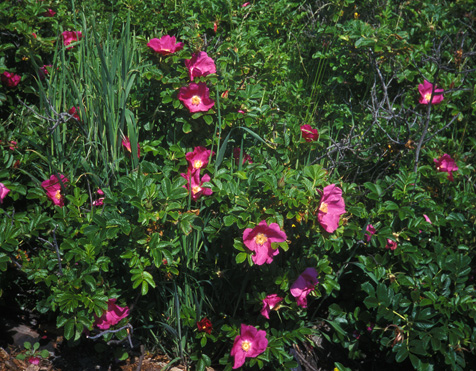
|
Roses
|
| In June the air will be thick with the aroma of roses. Bees will
be deliriously engaged, aphids sipping happily, and love in the air.
Right now is a swell time to prune or plant roses. Roses are the world's
favorite flowers. The love of roses borders on idolatry thanks to poets
and romantic European mindsets in general. The rest of the world
followed. For intrinsic beauty and fragrance many other plants are equal. Think
of lilies, magnolia, Plumeria, to cite a few. Even diehard rosarians admit
that other flowers usually don't grow on sticker bushes. |
| Since roses are so beloved, breeders have responded and it seems
a million different kinds exist. Catalog pictures flaunt gorgeous
roses whose form, size and color are immaculate, whose fragrance we
imagine to be of heavenly sweetness. |
| So we cannot resist and buy a rose. Now what? Head scratching
and wondering where to plant it. In a new spot or to replace an old rose?
The more we know the more we fret. What about rose replant
disease, powdery mildew, blackspot, rose mosaic virus, rootstock suckering
and long-term incompatibility? What sort and amount of fertilizer? Will
the new rose be the right size and growth habit for its intended place in
the garden? Who knows. |
| There is good news. People can choose from a rich array of
roses, making choices which ideally fit personal needs and preferences. You
can do anything from a formal garden of hybrid tea roses to a wild
approach of going native. You can nurture miniatures a foot tall, or send
climbers 60 feet up trees. |
| The big concern with most rose growers locally is blackspot, a
fungal disease that looks like it sounds, and knocks off leaves prematurely.
But with so many roses for sale, we should plant only those kinds
wholly immune or practically resistant. Then we don't need to look at ugly
roses, or spray. Thus, choosing varieties is crucial. |
| As with many gardening and natural history things, Seattleites
are fortunate in roses. Three species grow native here:
Rosa nutkana, R. pisocarpa, and R.
gymnocarpa. For a list of 1,170 other kinds which
can be bought this spring from 30 local nurseries, send $5 to Ron
Brightman, 9004 184th SW, Edmonds, WA 98020. This amazingly helpful list let
me find local sources for two promising roses I sought --'Summer Wine'
and 'Leverkusen'. |
As time goes on and you observe many roses, read about them,
and learn which ones are your best bets, you'll be able to suit yourself.
For example, it sounds stupid, but I don't
care what a rose looks like if it makes delicious hips. After tasting hips from dozens of roses, I found
the best: European dog rose (Rosa canina).
|
(originally published in The Seattle Weekly, March 1997)
Back |
|
|

